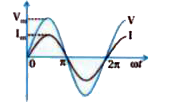Explain AC voltage applied to a resistor and explain it with necessary graph. Solution in Gujrati
Figure shows a resistor connected to an ac voltage.

Here consider a source which produces sinusoidally varying potential difference across its terminals. Such type of potential difference is called ac voltage.
∴ ac voltage V=Vmsinωt .....(1)
where Vm is the amplitude of the oscillating potential difference. Means maximum voltage and ω is its angular frequency.
From equation (1), V = IR
where I can be found by applying Kirchhoff.s loop rule,
∴ IR = Vmsinωt
∴I=VmRsinωt
but VmR=Im
∴ I =Imsinωt .....(2)
where the current amplitude is,
Im=VmR is just a Ohm.s law.
This relation works equally for both ac and dc voltage or current (signal ).
The voltage across a pure resistor and current through it are plotted as a function of time is shown in below graph.

In a pure resistor, the voltage and current are in phase.
The minima, zero and maxima occur at the same respective times.
The voltage and current are in phase with each other in pure resistor. Both reach zero. minimum and maximum values at the same time.
Here both V and I reach zero, minimum and maximum values at the same time, so the voltage and current are in phase with each other.
Topper's Solved these Questions
- ALTERNATING CURRENTS BOOK - KUMAR PRAKASHANCHAPTER - ALTERNATING CURRENTS EXERCISE - SECTION B NUMERICALS (TEXTUAL ILLUSTRATIONS)
33 Videos
- ALTERNATING CURRENTS BOOK - KUMAR PRAKASHANCHAPTER - ALTERNATING CURRENTS EXERCISE - SECTION B NUMERICALS ( TEXTUAL EXERCISE )
13 Videos
- ALTERNATING CURRENTS BOOK - KUMAR PRAKASHANCHAPTER - ALTERNATING CURRENTS EXERCISE - SECTION-D MCQs (COMPETITIVE EXAMS)
64 Videos
- ATOMSBOOK - KUMAR PRAKASHANCHAPTER - ATOMSEXERCISE - Section-D -MCQs asked in GUJCET / Board Exam
34 Videos
Similar Questions
A light bulb is rated at 100W for a 220 V supply. Find the resistance of the bulb
View SolutionA 100 Ω resistor is connected to a 200V, 50 Hz ac supply.
(a) What is the rms value of current in the circuit ?
(b) What is the net power consumed over a fully cycle ?
View SolutionPower factor of AC series circuit having resistance R and inductor L having angular frequency ω is ……..
View SolutionThe ratio of longest wavelength and the shortest wavelength observed in the 5 spectral series of emission spectrum of hydrogen is .......
View Solution220 V, 50 Hz , AC is applied to a resistor . The instantaneous value of voltage is
View SolutionExplain Maxwell distribution of molecular speed with necessary graph.
View Solutionकिसी परिपथ में प्रेरक L तथा संधारित्र C श्रेणीक्रम में लगे हैं। परिपथ पर आरोपित वोल्टेज सिग्नल, DC वोल्टेज तथा उच्च आवृत्ति के AC वोल्टेज का मिश्रण है। समझाइए कि DC वोल्टेज, C के सिरों पर तथा AC वोल्टेज, L के सिरों पर लगेगा।
View SolutionExplain the working of a single-phase AC generator with necessary diagram.
View SolutionExplain the working of a single-phase AC generator with necessary diagram.
View SolutionAlternating Current | Introduction, Ac Voltage Applied To A Resistor, Representation Of Ac Current And Voltage By Rotating Vectors -Phasors
View Solution120 V AC voltage is applied to 10 ohm resistance. The peak voltage across the resistor is
View SolutionExplain electrical energy when an ac current passes through a resistor.
View SolutionExplain AC circuit for circuit with only resistor.
View SolutionExplain Maxwell distribution of molecular speeds with necessary graph.
View SolutionAn AC voltage is applied acrss a series combination of L and R. If the voltage drop across the resistor and inductor are 20V and 15V respectiely, then applied peak voltage is
View Solution
